Surfing For Beginners – Before You Hit the Water
Watershed was founded out of love and respect for all things H20, but that doesn’t mean we stick to rivers, lakes and the deep blue – we love catching some waves as well. If you’ve never tried your hand at surfing, but have always wanted to, consider this your call to action. It’s a freeing, therapeutic sport that’s one of the most profound ways to connect with yourself and the great blue.
For more inspiration, check out our recent blog on the BIPOC Surf Collective, Textured Waves HERE
There are tons of amazing beginner resources available for getting techniques down once you’re in the water and on your board. That said, there are a lot of crucial things to think about before you get in the water.
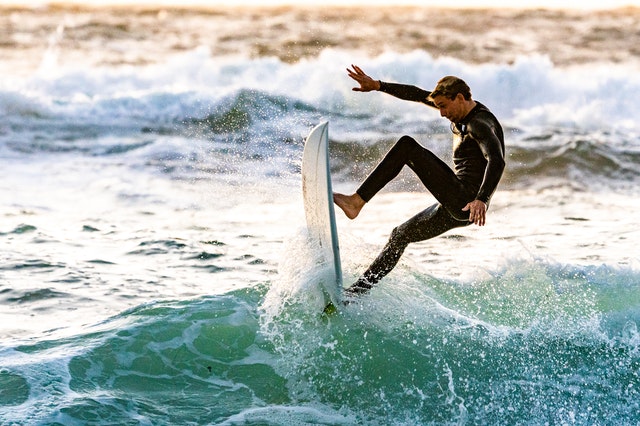
Photo by Guy Kawasaki
One thing worth disclaiming – your first couple of times will be rough. You may be tossed around, bonked by your board, and swimming more often than not. What’s important to remember is that this is a character defining moment in your surfing career! The more you begin to understand how your body – as well as the ocean – operates and moves under different conditions, the more refined and in-tune your balance and skills will become. Perseverance is key – as with any new sport!
Here are out top tips on how to get started:
1) Wetsuit
Investing in a quality wetsuit is a necessary cost to ensure that your body stays comfortable and temperature-regulated while out on the water. A little bit of this goes a long way when you’re under the sun all day moving around.
- Style: There are different styles of wetsuit, from full body, hooded ones, to short sleeves and jackets – with boots and gloves are additional accessories. You can base this decision based off of the climate you’ll be surfing in, as well as how much heat you tend to give off when exercising.
- Sizing/Temperature Rating: Thicker wetsuits will have higher r-value (warmth), so the higher the millimeter (mm) size, the warmer you’ll be. For temperatures over 75 degrees, you can opt out of a wetsuit for some board shorts and a swim shirt if you like. Below 70 degrees, any 2mm/3mm size wetsuit will do the trick – but from about 60 to 50, you’ll want to use 4-5mm. If you’re in 50 degrees or below, aim for 5-6mm.
The pricing of wetsuits takes into account many factors, such as brand, thickness, seam-stitching, zip/entry style and types of neoprene – the permeable rubber compound the suits are made of. There are a plethora of choices out there to suit your fit and temperature, and finding the right one can indeed make or break your experience. But just remember – you’ll only need to get one for your whole surfing career!
For a detailed guide on Wetsuit material, fit and construction, check out Clean Line Surf’s comprehensive wetsuit guide.
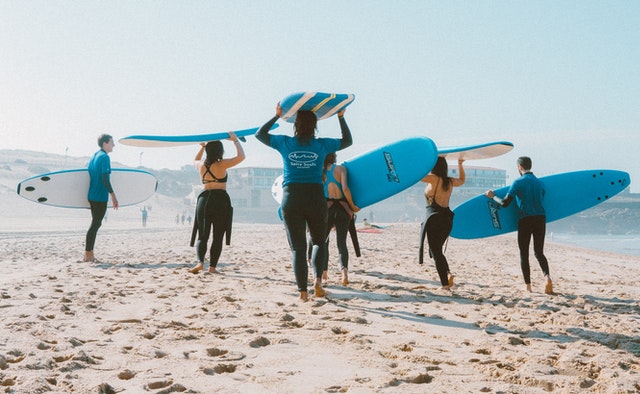
Photo by Elle Hughes
Board Features
There are several different types of surfboards, and some are better than others for getting started. Here are features we recommend aiming for when scoping out the board right for you and your humble surfer roots.
- Go Big – A larger board with a broader surface area will allow you more room to get a better feel for your balance. Additionally, they’re greater flotation devices.
- Soft Top – Your bum and toes will thank you. Your first days will be spent primarily sitting on the board, bracing yourself for another send. Also, it’ll be easier on your feet to get the hang of balancing without any discomfort.
- Surf Leash – A crucial safety asset that can potentially save your life, don’t sleep on these! Most boards will come with a leash.
For a beginner, the Costco Wavestorm board is a good starting point. These are widely accepted as the soft top board to start on, so much so you’ll find it super easy to find one second-hand online or at a local thrift store.
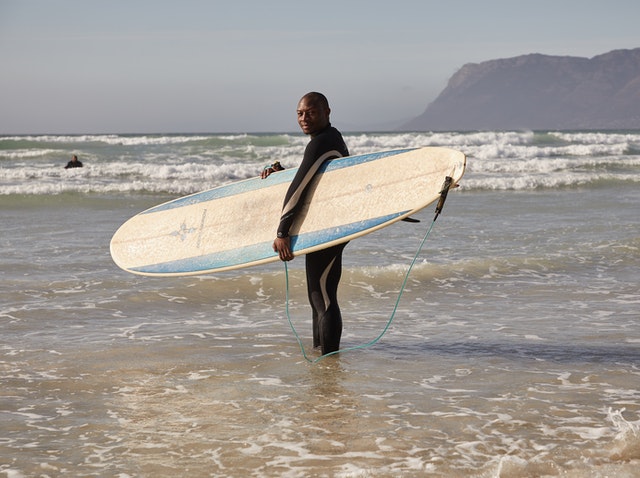
Photo by Laker
Getting in the Water
- The Prone Position – Before hopping in, one thing you want to master is assuming and mastering being prone on your board. It’s essentially laying flat and balanced on your board, experimenting with movements and weight – becoming one with the board. It will familiarize your reflexes with maintaining balance. It sounds silly, but a great way to start is laying on your board on the beach. Get comfy with you positioning, and remember where your chest lands on the board so you can quickly get into the right position when you catch your wave.
- The Lineup – You’ll want to pay attention to other folks in the water, also the area where waves are breaking known as the “lineup.” Those already in the water on the lineup have the right of way, and that’s okay, because your first day will be all about strengthening your endurance. You may also notice two lines of surfers. When you’re starting out, you don’t need waves any larger than a couple of feet to get the feel. Check the line of surfers closer to the shore and match them.
- Morale – Take a minute to center yourself mentally and emotionally. You may swim a little, but when you start to find your groove and understand your surroundings and abilities, you’ll feel the high. Simply just sitting up on your board (which can be a feat itself) and taking a second to collect yourself and take it all in helps a lot. Ride a couple of waves to shore on your belly as well. You’ll get the feel of the ocean and also gain some confidence to take the next step of popping up.
- Board Etiquette – Always keep your leash on your ankle so that your board stays close to you if you take a tumble. It’s also less likely to shoot out and hurt you or somebody else.
- Be Patient – This falls in line with morale, but pacing yourself is a huge part of getting the hang of the water as well as avoiding injury. This also means that you should be starting on smaller waves, and asking for tips and guidance from other surfers (turns out, surfers are a friendly bunch!) or your instructor if you have one.
Some last minute tips:
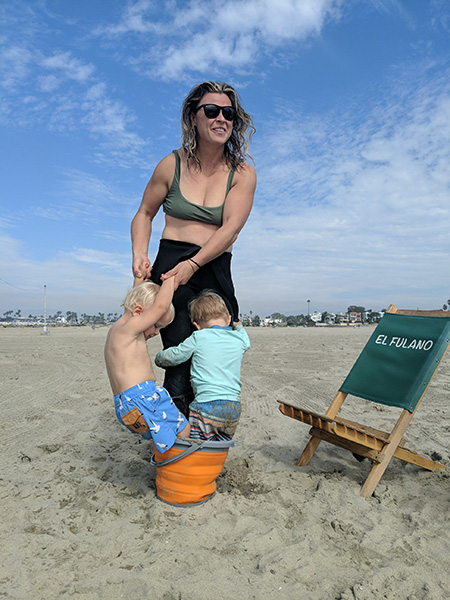
Watershed’s social media manager getting some assistance soaking a stingray sting in warm water.
SHUFFLE YOUR FEET!
When you’re learning to surf, there is no need to paddle out really far and wait for waves sitting on your board. It’s actually more difficult than it looks (hallo core muscles!), and as you can learn on waves no larger than 2-3 feet, you’ll be able to catch more surf standing in the shallows waiting to hop on your board. But, depending on where you are geographically, you may have company! In places like southern Florida and Southern California, stingrays may also be hanging out in the shallows (especially in the winter months when the water is warmer and there are typically less surfers/traffic in the water). It’s generally good practice to shuffle your feet whenever you’re wading out to your spot. By walking like this – similar to how you would on slippery ice – the stingrays theoretically will feel your vibrations and leave before you get there. You’re also less likely to accidently stand on one which is when you’ll discover how the stingray got their name (Sidenote: it actually feels more like a stab, and then the sting hits!).
If you do get stung/stabbed – don’t panic! Head out of the water as soon as you can and find hot (as hot as you can stand it!), fresh water to soak your wound in. The heat of the water helps break down the proteins in the stingrays ‘sting’, which is what causes you pain. By soaking it in water you should feel some relief within a couple of hours. It’s also good practice to check with the lifeguards on the beach to make sure you don’t need further medical attention, and if you’re experiencing any side effects (shortness of breath etc) – or if the sting is around your throat, chest or any major artery – seek medical help ASAP.
Wear Sunscreen
As soon as you start surfing, you’ll notice how time FLIES when you’re out on the water. You think you’ve been out for 15 minutes – on a surf clock it’s actually been an hour. Because of this – invest in a good sunblock for your face (and anywhere else that may not be covered by your wetsuit). If you’re light on the hair up top, you can also find surf caps to help protect you a little more. These are also a great idea if the sun is bothering your eyes as you’re squinting out into the horizon seeking your next wave…
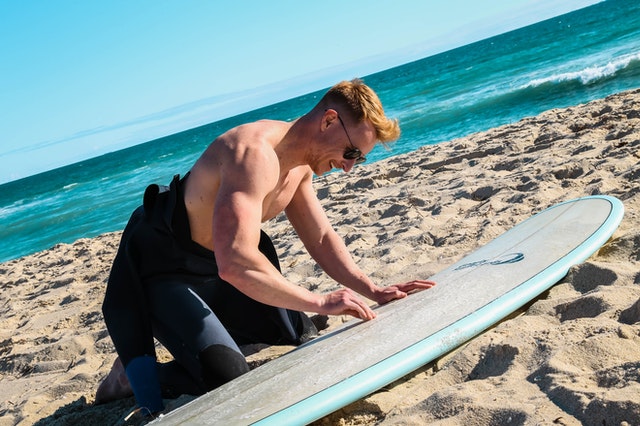
Photo by Amanda Klamrowski
Board Wax
Unlike skiing and snowboarding, surf board wax is applied onto the top of your board (the side you lay on) and acts essentially as glue, sticking you to your board and giving you a better chance of being in control when you catch your wave. Apply LOTS of wax to where your chest and your feet will land on the board, plus a good smothering on each side of the board to so your hands don’t slip when you’re pushing yourself up. Without wax, the ocean water can get between you and the board when the waves come pushing you off before you even try and stand.
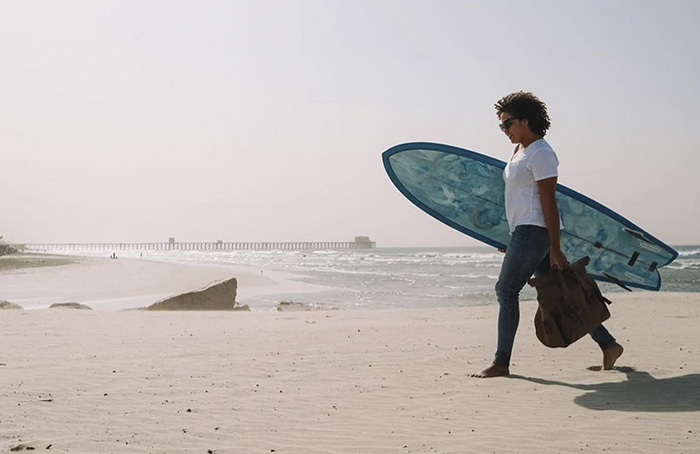
Textured Waves co-found, Danielle Black Lyons.
📷 © @saltyphotosandiego
Bring your Drybag
This one is super simple – do you like loads of salt water and sand covering the inside of your car, or would you prefer your wet wetsuit to be safely tucked away in a Drybag? Second one? Us too. Not only to our duffels and backpacks keep water 100% out, but they also keep wet things 100% in! We like the Animas for the Chattooga for beach vibes.
With this information in your tool kit, you’ll hopefully be a bit more ready to tackle your first wave. As always, never be afraid to ask questions, make good decisions, and don’t give up. Most importantly – have fun!

